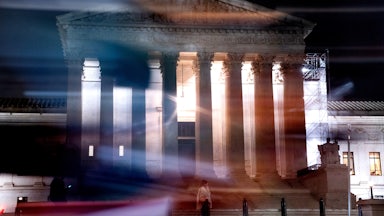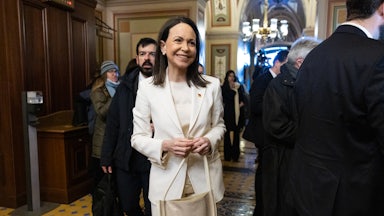The Rolling Stones once said that you can’t always get what you want. While they were writing about love, the same principle also holds true for venue requirements in lawsuits against the Environmental Protection Agency over Clean Air Act regulations—at least for now.
The Supreme Court took up three cases on Monday where it could tilt the field further in favor of polluters and their right-wing allies in state governments. At issue in these cases is how to read the venue provisions of the Clean Air Act, which determine which of the federal circuit courts of appeal reviews legal challenges to EPA rules.
Under the act’s text, rules and regulations that are “nationally applicable” are generally heard in the D.C. Circuit Court of Appeals, while those that are “locally or regionally applicable” are heard in the appeals court where they take effect. Alternatively, the EPA can transfer one of the latter cases if it concludes that it would have a nationwide impact.
It is not unusual for Congress to specify that certain regulatory appeals must be heard in a specific circuit court of appeal. By transferring the relevant cases to the D.C. Circuit, the law’s venue requirements reduce the risk of circuit splits and inconsistent rulings on a major federal law with significant economic implications. EPA lawyers based in the nation’s capital also do not have to continuously roam the country to argue before different courts about the same issues.
In two of the cases taken up by the justices, Republican-led states and the energy industry asked the high court to intervene. Oklahoma v. EPA and PacifiCorp v. EPA are challenges to the agency’s use of the Clean Air Act’s “good neighbor” provision. All states are required to meet certain federal air quality standards. The provision requires some upwind states to take additional steps to ensure that their emissions don’t affect downwind states’ ability to meet those standards.
In 2015, the EPA revised its air quality standards by lowering the acceptable level of ozone from 75 parts per billion to 70 ppb. The agency noted that ozone poses particular issues because it travels long distances compared to other emissions. Under the CAA, states submitted new compliance plans to meet the revised threshold. The EPA has the power to approve the state plans, or it can enact a new federal plan in their place if the agency concludes that the states’ version is insufficient to meet the targets.
“After reviewing the submissions, EPA issued a final rule in which it concluded that [21] states’ submissions—each of which proposed no additional emissions reductions to meet the more stringent ozone standard—must be disapproved because they did not comply with the Good Neighbor provision,” the agency told the justices in a brief for the court. Among them were Oklahoma and Utah, who sued the EPA to challenge its conclusions.
The states, as well as the industry plaintiffs in PacifiCorp, sought to reverse the EPA’s findings on multiple grounds. Among other things, they claimed that the existing plans were sufficient to address ozone pollution under the new threshold and that other upwind states bore more responsibility for the downwind emissions. Before the two sides could address the merits of the case, however, they had to figure out which court could hear it.
The states and the energy industry argued that the proper venue was the Tenth Circuit Court of Appeals, which covers most of the Mountain West. (Unlike most federal lawsuits, these cases are not first heard by a federal district court.) Accordingly, they sought review of the EPA’s actions in that court. The agency, on the other hand, asked the Tenth Circuit to transfer the case to the D.C. Circuit, arguing that rejecting the states’ plans and imposing a new one in their place amounted to a “nationally applicable” action.
“The disapproval action is nationally applicable on its face because it applies a uniform process and standard to [21] states across the country,” the EPA argued in its briefs. “And even if the action could be characterized as locally or regionally applicable, it is based on multiple determinations of nationwide scope or effect.”
The Tenth Circuit panel unanimously sided with the agency. “Considering the action ‘on its face,’ the [lower] court recognized that it applies to states far beyond a single judicial circuit’s boundaries; it reflects EPA analyses common across those states; and it addresses the effects of transient air pollution that travels between states,” the EPA explained to the justices in its reply brief.
The states strenuously disagreed with that conclusion. “At bottom, the Tenth Circuit’s decision grants EPA the power to ‘transform’ the ‘proper forum for judicial review’ by packaging multiple ‘regionally applicable’ actions into a single Federal Register notice, and therefore making it a ‘nationally applicable action,’” they told the justices in their petition for review. “That holding badly misinterprets the Clean Air Act, and it adopts a view of venue that improperly elevates the form of an EPA action over its substance.”
While the states were unsuccessful before the Tenth Circuit, industry challengers in other jurisdictions have been more successful. The third case, Environmental Protection Agency v. Calumet Shreveport Refining, centered on the agency’s Renewable Fuel Standard program. Six small refineries in Louisiana, Mississippi, and Texas—the three states that fall within the Fifth Circuit Court of Appeals—sought hardship exemptions from the standard, which the EPA denied in 2022. They then mounted a legal challenge to the agency’s actions in the Fifth Circuit.
The EPA argued that those denials “are subject to review exclusively in the D.C. Circuit because they are ‘nationally applicable’ or, in the alternative, because they are ‘based on a determination of nationwide scope or effect,’” quoting from the Clean Air Act. The Fifth Circuit panel disagreed and declined to transfer the case, ultimately ruling against the EPA on the merits as well. In a 38-page ruling, it concluded that the denials instead counted as “locally or regionally applicable” under the law’s venue requirements. The agency asked the justices to review that conclusion as well.
An additional wrinkle in this dispute is the lineup of justices who will consider it. When the court announced it would take up the petitions and consolidate them on Monday, it also said that Justice Samuel Alito would recuse himself from the case. The court did not explain the reason for his recusal. Based on the usual factors that the justices consider for recusal, the likeliest explanation is that he owns shares in one or more of the companies involved in the litigation. While the court’s liberals would still need two conservative votes to prevail in a ruling, they would now only need one to deadlock it with a 4–4 split.
If the Supreme Court makes it easier for states and companies to avoid the D.C. Circuit in environmental cases, those litigants will likely face much friendlier judges going forward. The Fifth Circuit, which easily ranks as the most conservative federal court in the country, is a dream venue for any business facing an EPA enforcement action or new regulatory scheme. Nearly every lawsuit filed by Republican state attorneys general against the Biden administration’s policies is brought there. Far-right billionaire Elon Musk even recently amended Twitter’s terms of service to require any litigation by users to be brought before a specific federal court division in northern Texas, where the lone federal judge assigned to it is a Tesla shareholder.
These cases do not directly address the phenomenon of judge shopping that plagues the Fifth Circuit. Nor can the Supreme Court itself really do anything to address it on a comprehensive level—that responsibility instead lies with Congress. What the justices could do, however, is make things worse by bending the Clean Air Act’s language to make it easier for polluters to find friendlier judges in other courts. Oral arguments in the case will likely be scheduled for next spring, with a ruling to come by the end of next June.










